England in the High Middle Ages

In the
Henry had extensive holdings in France and asserted his authority over Wales, Scotland and Ireland. He clashed with his appointee to the
The Normans adopted many Anglo-Saxon governmental institutions, but the feudal system concentrated more power in the hands of the monarch and a small elite. The rights and roles of women became more sharply defined. Noblewomen remained significant cultural and religious patrons and played an important part in political and military events. During the twelfth century divisions between conquerors and the English began to dissolve and they began to consider themselves superior to their Celtic neighbours. The conquest brought Norman and French churchmen to power. New reformed religious and military orders were introduced into England. By the early thirteenth century the church had largely won its argument for independence from the state, answering almost entirely to Rome. Pilgrimages were a popular religious practice and accumulating relics became important for ambitious institutions. England played a prominent role in the Second, Third and Fifth Crusades.
Between the ninth and thirteenth centuries England experienced the
| Periods in English history |
|---|
| Timeline |
Political history
Normans
Norman conquest
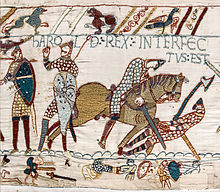
In 1002 King Æthelred II of England married Emma, the sister of Richard II, Duke of Normandy.[1] Their son Edward the Confessor, who spent many years in exile in Normandy, succeeded to the English throne in 1042.[2] This led to the establishment of a powerful Norman interest in English politics, as Edward drew heavily on his former hosts for support, bringing in Norman courtiers, soldiers, and clerics and appointing them to positions of power, particularly in the Church. Childless and embroiled in conflict with the formidable Godwin, Earl of Wessex, and his sons, Edward may also have encouraged Duke William of Normandy's ambitions for the English throne.[3]
When King Edward died at the beginning of 1066, the lack of a clear heir led to a disputed succession in which several contenders laid claim to the throne of England.
William I (1066–87)

Major revolts followed, which William suppressed before intervening in the north-east of England, establishing Norman control of York and

To find the lands to compensate his Norman followers, William initially confiscated the estates of all the English lords who had fought and died with Harold and redistributed part of their lands.
At Christmas 1085, William ordered the compilation of a survey of the landholdings held by himself and by his vassals throughout the kingdom, organised by counties, a work now known as the Domesday Book. The listing for each county gives the holdings of each landholder, grouped by owners. The listings describe the holding, who owned the land before the Conquest, its value, what the tax assessment was, and usually the number of peasants, ploughs, and any other resources the holding had. Towns were listed separately. All the English counties south of the River Tees and River Ribble are included, and the whole work seems to have been mostly completed by 1 August 1086, when the Anglo-Saxon Chronicle records that William received the results and that all the chief magnates swore the Salisbury Oath, a renewal of their oaths of allegiance.[27]
William II (1087–1100)
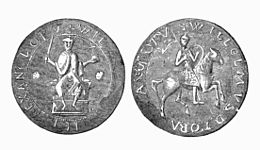
At the death of William the Conqueror in 1087 his lands were divided into two parts. His Norman lands went to the eldest son
Henry I (1100–35)
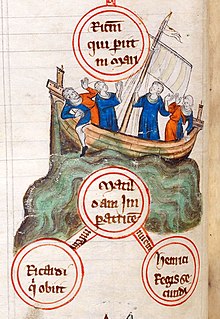
Despite Robert's rival claims, his younger brother Henry immediately seized power in England.[31] Robert, who invaded in 1101, disputed Henry's control of England. This military campaign ended in a negotiated settlement that confirmed Henry as king. The peace was short-lived, and Henry invaded the Duchy of Normandy in 1105 and 1106, finally defeating Robert at the Battle of Tinchebray. Henry kept Robert imprisoned for the rest of his life. Henry's control of Normandy was challenged by Louis VI of France, Baldwin of Flanders and Fulk of Anjou, who promoted the rival claims of Robert's son, William Clito, and supported a major rebellion in the Duchy between 1116 and 1119. Following Henry's victory at the Battle of Brémule, a favourable peace settlement was agreed with Louis in 1120.[32]
Considered by contemporaries to be a harsh but effective ruler, Henry skilfully manipulated the barons in England and Normandy. In England, he drew on the existing Anglo-Saxon system of justice, local government and taxation, but also strengthened it with additional institutions, including the royal
Stephen, Matilda and the Anarchy (1135–54)
Henry's only legitimate son, William, died aboard the White Ship in the disaster of 1120, sparking a fresh succession crisis. Henry named his daughter Matilda as his heir,[38] but on Henry's death in 1135 her cousin Stephen of Blois had himself proclaimed king.[39] Matilda's husband Geoffrey, Count of Anjou showed little interest in England, but he supported Matilda by entering Normandy to claim her inheritance.[40] Matilda landed in England to challenge Stephen and was declared "Lady of the English",[41] which resulted in a civil war called the Anarchy. Stephen was defeated and captured at the Battle of Lincoln (1141) and Matilda was the effective ruler. When Matilda was forced to release Stephen in a hostage exchange for her half-brother Robert, 1st Earl of Gloucester, Stephen was re-crowned. The conflict in England continued inconclusively. However, Geoffrey secured the Duchy of Normandy. Matilda's son, Henry II, by his marriage to Eleanor of Aquitaine had acquired the Duchy of Aquitaine and was now immensely rich. With skilful negotiation with the war-weary barons of England and King Stephen, he agreed to the Treaty of Wallingford and was recognised as Stephen's heir.[42]
Angevins
Henry II (1154–89)
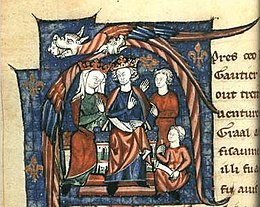
After Stephen's death in 1154 Henry succeeded as the first Angevin king of England, so-called because he was also the Count of Anjou in Northern France, adding it to his extensive holdings in Normandy and Aquitaine.[43] England became a key part of a loose-knit assemblage of lands spread across Western Europe, later termed the Angevin Empire.[44]
Henry asserted his authority over Brittany, even reorganising the Duchy into eight administrative districts and introducing Angevin legal reforms.[45] He pursued an aggressive policy in Wales, reclaiming lands lost by Anglo-Norman princes and conducting four punitive campaigns against Welsh princes that resulted in their submission to his authority. This underlined his overlordship, but he did not attempt a direct conquest. When the Scottish king William the Lion joined the rebellion of Henry's sons and was captured, it allowed Henry to extract homage from the Scottish king under the Treaty of Falaise (1174), which he did not pursue directly, but which would provide a justification for later interventions in Scottish kingship.[46]
In the mid-twelfth century Ireland was ruled by local

Henry saw an opportunity to re-establish what he saw as his rights over the Church in England by reasserting the privileges held by Henry I when
When Henry II attempted to give his land-less youngest son, John, a wedding gift of three castles it prompted his three eldest sons and wife to rebel in the revolt of 1173–1174. Louis VII encouraged the three elder sons to destabilise his mightiest subject and not to wait for their inheritances. It was only after eighteen months of conflict that Henry II was able to force the rebels to submit to his authority.[58] In Le Mans in 1182 Henry II gathered his children to plan for partible inheritance in which his eldest son, also called Henry, would inherit England, Normandy and Anjou; Richard the Duchy of Aquitaine; Geoffrey Brittany and John would receive Ireland. This broke down into further conflict and the younger Henry rebelled again, but died of dysentery. In 1186 Geoffrey died as a result of a tournament accident but Henry was still reluctant to have a sole heir[59] so, in 1189, Richard and Philip II of France took advantage of a sickening Henry II with more success. Henry II was forced to accept humiliating peace terms, including naming Richard as sole heir. When Henry II died shortly afterwards his last words to Richard were allegedly "God grant that I may not die until I have my revenge on you".[60]
Richard I (1189–99)

On the day of Richard's coronation there was a mass slaughter of the Jews, described by
Opinions of Richard amongst his contemporaries were mixed. He had rejected and humiliated the king of France's sister; insulted and refused spoils of the
Richard was captured by Leopold on his return journey in 1192. Custody was passed to Henry the Lion and a tax of 25 per cent of movables and income was required in England to pay the ransom of 100,000 marks, with a promise of 50,000 more, before Richard was released in 1194. In his absence Philip II of France had overrun much of Normandy, while John of England controlled much of the remainder of Richard's lands. On his return to England, Richard forgave John and re-established his control. Leaving England in 1194 never to return, Richard battled Phillip for the next five years for the return of the holdings seized during his incarceration. Close to total victory he was injured by an arrow during the siege of Château de Châlus-Chabrol and died after lingering injured for ten days.[66]
John (1199–1216)

Richard's failure in his duty to provide an heir caused a succession crisis. Anjou, Brittany, Maine and Touraine chose Richard's nephew and nominated heir, Arthur, while John succeeded in England and Normandy. Yet again Philip II of France took the opportunity to destabilise the Plantagenet territories on the European mainland, supporting his vassal Arthur's claim to the English crown. When Arthur's forces threatened his mother, John won a significant victory, capturing the entire rebel leadership at the Battle of Mirebeau.[67] Arthur was murdered, it was rumoured by John's own hands, and his sister Eleanor would spend the rest of her life in captivity. John's behaviour drove numerous French barons to side with Phillip. The resulting rebellions by the Norman and Angevin barons broke John's control of the continental possessions, leading to the de facto end of the Angevin Empire, even though Henry III would maintain the claim until 1259.[68]
After re-establishing his authority in England, John planned to retake Normandy and Anjou. The strategy was to draw the French from Paris while another army, under Otto IV, Holy Roman Emperor, attacked from the north. However, his allies were defeated at the Battle of Bouvines in one of the most decisive and symbolic battles in French history.[69] The battle had both important and high-profile consequences.[70] John's nephew Otto retreated and was soon overthrown while King John agreed to a five-year truce. Philip's decisive victory was crucial in ordering politics in both England and France. The battle was instrumental in forming the absolute monarchy in France.[71]
John's defeats in France weakened his position in England. The rebellion of his English vassals resulted in the treaty called
Government
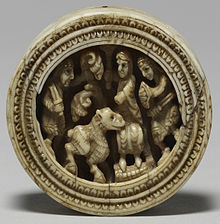
Within twenty years of the Norman conquest, the Anglo-Saxon elite had been replaced by a new class of Norman nobility.[76] The new earls (successors to the ealdermen), sheriffs and senior clergy were all drawn from their ranks.[77] In many areas of society there was continuity, as the Normans adopted many of the Anglo-Saxon governmental institutions, including the tax system, mints and the centralisation of law-making and some judicial matters; initially sheriffs and the hundred courts continued to function as before.[78]
The method of government after the conquest can be described as a
At the centre of power, the kings employed a succession of clergy as
Many tensions existed within the system of government.[89] Royal landowning and wealth stretched across England, and placed the king in a privileged position above even the most powerful of the noble elite.[90] Successive kings still needed more resources to pay for military campaigns, conduct building programmes, or to reward their followers, and this meant exercising their feudal rights to interfere in the land-holdings of nobles.[91] This was contentious and a frequent issue of complaint, as there was a growing belief that land should be held by hereditary right, not through the favour of the king.[92] Property and wealth became increasingly focused in the hands of a subset of the nobility, the great magnates, at the expense of the wider baronage, encouraging the breakdown of some aspects of local feudalism.[93] As time went by, the Norman nobility intermarried with many of the great Anglo-Saxon families, and the links with the Duchy began to weaken.[94] By the late twelfth century, mobilising the English barons to fight on the continent was proving difficult, and John's attempts to do so ended in civil war.[95]
Society
Women in society

Medieval England was a patriarchal society and the lives of women were heavily influenced by contemporary beliefs about gender and authority.[96] However, the position of women varied according to factors including their social class; whether they were unmarried, married, widowed or remarried; and in which part of the country they lived.[97] Significant gender inequities persisted throughout the period, as women typically had more limited life-choices, access to employment and trade, and legal rights than men.[98] After the Norman Conquest, the position of women in society changed. The rights and roles of women became more sharply defined, in part as a result of the development of the feudal system and the expansion of the English legal system; some women benefited from this, while others lost out.[99] The rights of widows were formally laid down in law by the end of the twelfth century, clarifying the right of free women to own property, but this did not necessarily prevent women from being forcibly remarried against their wishes.[100]
The growth of governmental institutions under a succession of bishops reduced the role of queens and their households in formal government. Married or widowed noblewomen remained significant cultural and religious patrons and played an important part in political and military events, even if chroniclers were uncertain if this was appropriate behaviour.
Identity
The Normans and French who arrived after the conquest saw themselves as different from the English. They had close family and economic links to the Duchy of Normandy, spoke
Religion
Ecclesiastical structures and orders
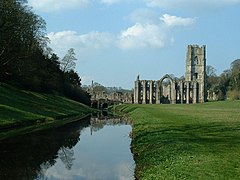
The 1066 Norman conquest brought a new set of Norman and French churchmen to power; some adopted and embraced aspects of the former Anglo-Saxon religious system, while others introduced practices from Normandy.[110] Extensive English lands were granted to monasteries in Normandy, allowing them to create daughter priories and monastic cells across the kingdom.[111] The monasteries were brought firmly into the web of feudal relations, with their holding of land linked to the provision of military support to the crown.[112] The Normans adopted the Anglo-Saxon model of monastic cathedral communities, and within seventy years the majority of English cathedrals were controlled by monks; every English cathedral, however, was rebuilt to some extent by the new rulers.[113] England's bishops remained powerful temporal figures, and in the early twelfth-century raised armies against Scottish invaders and built up extensive holdings of castles across the country.[114]
New orders began to be introduced into England. As ties to Normandy waned, the French
Church and state

William the Conqueror acquired the support of the Church for the invasion of England by promising ecclesiastical reform.
Pilgrimages
Pilgrimages were a popular religious practice throughout the Middle Ages in England, with the tradition dating back to the Roman period.[124] Typically pilgrims would travel short distances to a shrine or a particular church, either to do penance for a perceived sin, or to seek relief from an illness or other condition.[125] Some pilgrims travelled further, either to more distant sites within Britain or, in a few cases, on to the continent.[126] Under the Normans, religious institutions with important shrines, such as Glastonbury, Canterbury and Winchester, promoted themselves as pilgrimage destinations, maximising the value of the historic miracles associated with the sites.[127] Accumulating relics became an important task for ambitious institutions, as these were believed to hold curative powers and lent status to the site.[128] By the twelfth century reports of posthumous miracles by local saints were becoming increasingly common in England, adding to the attractiveness of pilgrimages to prominent relics.[129]
Crusades
The idea of undertaking a pilgrimage to
Geography

England had a diverse geography in the medieval period, from the
Of the 10,000 miles of roads that had been built by the Romans, many remained in use and four were of particular strategic importance—the Icknield Way, the Fosse Way, Ermine Street and Watling Street—which criss-crossed the entire country.[137] The road system was adequate for the needs of the period, although it was significantly cheaper to transport goods by water.[138] The major river networks formed key transport routes, while many English towns formed navigable inland ports.[139]
For much of the Middle Ages, England's climate differed from that in the twenty-first century. Between the ninth and thirteenth centuries England went through the
Economy and demography
The English economy was fundamentally
Although the Norman invasion caused some damage as soldiers looted the countryside and land was confiscated for castle building, the English economy was not greatly affected.[146] Taxes were increased, however, and the Normans established extensive forests that were exploited for their natural resources and protected by royal laws.[147] The next two centuries saw huge growth in the English economy, driven in part by the increase in the population from around 1.5 million in 1086 to between 4 and 5 million in 1300.[148] More land, much of it at the expense of the royal forests, was brought into production to feed the growing population and to produce wool for export to Europe.[149] Many hundreds of new towns, some of them planned communities, were built across England, supporting the creation of guilds, charter fairs and other medieval institutions which governed the growing trade.[150] Jewish financiers played a significant role in funding the growing economy, along with the new Cistercian and Augustinian religious orders that emerged as major players in the wool trade of the north.[151] Mining increased in England, with a silver boom in the twelfth century helping to fuel the expansion of the money supply.[152]
Warfare
Anglo-Norman warfare was characterised by
Naval forces played an important role during the Middle Ages, enabling the transportation of troops and supplies, raids into hostile territory and attacks on enemy fleets.[157] English naval power became particularly important after the loss of Normandy in 1204, which turned the English Channel from a friendly transit route into a contested and critical border region.[158]
Although a small number of castles had been built in England during the 1050s, after the conquest the Normans began to build timber
Culture
Art
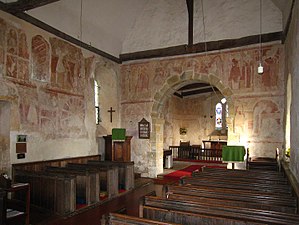
The Norman conquest introduced northern French artistic styles, particular in illuminated manuscripts and murals, and reduced the demand for carvings.[163] In other artistic areas, including embroidery, the Anglo-Saxon influence remained evident into the twelfth century, and the famous Bayeux Tapestry is an example of older styles being reemployed under the new regime.[164] Stained glass had been introduced into Anglo-Saxon England. Very few examples of glass survive from the Norman period, but there are a few examples that survive from minor monasteries and parish churches. The largest collections of twelfth-century stained glass at the Cathedrals of York and Canterbury.[165]
Literature and music
Poetry and stories written in French were popular after the Norman conquest, and by the twelfth century some works on English history began to be produced in French verse.
Architecture
The Normans brought with them architectural styles from their own duchy, where austere stone churches were preferred. Under the early Norman kings this style was adapted to produce large, plain cathedrals with ribbed vaulting.[171] During the twelfth century the Anglo-Norman style became richer and more ornate, with pointed arches derived from French architecture replacing the curved Romanesque designs; this style is termed Early English Gothic and continued, with variation, throughout the rest of the Middle Ages.[172] In domestic architecture, the Normans, having first occupied the older Anglo-Saxon dwellings, rapidly beginning to build larger buildings in stone and timber. The elite preferred houses with large, ground-floor halls but the less wealthy constructed simpler houses with the halls on the first floor; master and servants frequently lived in the same spaces.[173] Wealthier town-houses were also built using stone, and incorporated business and domestic arrangements into a single functional design.[174]
Popular representations
The period has been used in a wide range of popular culture.
See also
References
Notes
- ^ Williams 2003, p. 54
- ^ Huscroft 2005, p. 3
- ^ Stafford 1989, pp. 86–99
- ^ a b Higham 2000, pp. 167–181
- ^ Walker 2000, pp. 136–138
- ^ Bates 2001, pp. 73–77
- ^ Higham 2000, pp. 188–190
- ^ Huscroft 2005, pp. 12–14
- ^ Thomas 2007, pp. 33–34
- ^ Walker 2000, pp. 158–165
- ^ Carpenter 2004, pp. 72–74
- ^ Douglas 1964, p. 216
- ^ Carpenter 2004, p. 76
- ^ Stafford 1989, pp. 102–105
- ^ Carpenter 2004, pp. 82–83
- ^ Carpenter 2004, pp. 79–80
- ^ a b c Carpenter 2004, p. 84
- ^ a b c Krieger, Neill & Jantzen 1992, p. 233
- ^ Carpenter 2004, pp. 83–84
- ^ Carpenter 2004, pp. 75–76
- ^ Chibnall 1986, pp. 11–13
- ^ Kaufman and Kaufman 2001, p. 110
- ^ Carpenter 2004, p. 89
- ^ Carpenter 2004, pp. 110–112
- ^ Carpenter 2004, pp. 125–126
- ^ Prestwich 1992, pp. 70–71 and 74
- ^ Bates 2001, pp. 198–202
- ^ Carpenter 2004, p. 129
- ^ Carpenter 2004, p. 132
- ^ Barlow 2000, pp. 402–406
- ^ Carpenter 2004, pp. 134–135
- ^ Huscroft 2009, pp. 65, 69–71; Carpenter 2004, pp. 124, 138–140
- ^ Hollister 2003, pp. 356–357 and 358–359
- ^ Green 2009, pp. 242–243
- ^ Green 2009, p. 255
- ^ Green 2009, p. 273
- ^ Green 2009, p. 278
- ^ Hooper 1996, p. 50
- ^ a b Schama 2000, p. 117
- ^ Grant 2005, p. 7
- ^ Carpenter 2004, p. 171
- ^ Ashley 2003, p. 73
- ^ Carpenter 2004, p. 191
- ^ Carpenter 2004, p. 191; Aurell 2003, p. 15
- ^ Davies 1990, p. 67
- ^ Davies 1990, p. 76
- ^ Warren 2000, pp. 187–188
- ^ Warren 2000, p. 192
- ^ Warren 2000, pp. 192–193
- ^ Warren 2000, p. 194
- ^ Carpenter 2004, p. 215
- ^ Bull 2007, p. 124; Warren 2000, p. 197
- ^ Warren 2000, p. 200
- ^ Warren 2000, p. 203
- ^ Warren 2000, p. 203; Davies 1990, pp. 64–65 and 78
- ^ Barlow 1986, pp. 234–235
- ^ Schama 2000, p. 142
- ^ Jones 2012, pp. 82–92
- ^ Jones 2012, p. 86
- ^ Jones 2012, p. 109
- ^ Ackroyd 2000, p. 54
- ^ Flori 1999, p. 116
- ^ Flori 1999, p. 132
- ^ Jones 2012, p. 128
- ^ Carlton 2003, p. 42
- ^ Jones 2012, p. 146
- ^ Turner 1994, pp. 100
- ^ Jones 2012, pp. 161–169
- ^ Favier 1993, p. 176
- ^ Contamine 1992, p. 83
- ^ Smedley 1836, p. 72
- ^ Jones 2012, p. 217.
- ^ Hamilton 2010, p. 1
- ^ Jones 2012, pp. 221–222.
- ^ Danziger and Gillingham 2003, p. 271
- ^ Carpenter 2004, p. 4; Davies 1990, p. 20; Huscroft 2005, p. 81
- ^ Burton 1994, p. 21; Barlow 1999, p. 87
- ^ Huscroft 2005, pp. 78–79
- ^ Carpenter 2004, pp. 84–85; Barlow 1999, pp. 88–89
- ^ Carpenter 2004, pp. 84–85 and 94; Huscroft 2005, p. 104
- ^ Carpenter 2004, p. 87
- ^ Danziger and Gillingham 2003, p. 40
- ^ Carpenter 2004, p. 52
- ^ Douglas 1964, p. 312
- ^ Huscroft 2005, p. 85
- ^ Bartlett 2002, pp. 395–402
- ^ Krieger, Neill & Jantzen 1992, p. 234
- ^ Carpenter 2004, pp. 290–292
- ^ Huscroft 2005, p. 104
- ^ Huscroft 2005, p. 95
- ^ Barlow 1999, p. 320
- ^ Carpenter 2004, p. 87; Barlow 1999, p. 320; Dyer 2009, pp. 108–109
- ^ Pounds 1994, pp. 146–147; Carpenter 2004, pp. 399–401 and 410
- ^ Barlow 1999, pp. 308–309
- ^ Carpenter 2004, pp. 369–70; Stenton 1976, pp. 56–57
- ^ Mate 2006, pp. 6–7, 97–99
- ^ Mate 2006, pp. 2–3; Johns 2003, p. 14
- ^ Mate 2006, pp. 98–99
- ^ Johns 2003, pp. 25, and 195–196; Mate 2006, pp. 20–21
- ^ Mate 2006, pp. 21–23
- ^ Johns 2003, pp. 22–25, 30 and 69; Mate 2006, p. 25
- ^ Mate 2006, p. 26
- ^ Carpenter 2004, p. 3
- ^ Carpenter 2004, pp. 6–7
- ^ Carpenter 2004, p. 6
- ^ Carpenter 2004, pp. 3–4 and 8
- ^ Davies 1990, pp. 18–20; Carpenter 2004, p. 9; Danziger and Gillingham 2003, p. 219
- ^ Davies 1990, pp. 20–22
- ^ Rubin 2006, p. 106
- ^ Burton 1994, pp. 23–24.
- ^ Burton 1994, pp. 29–30
- ^ Burton 1994, p. 28
- ^ Burton 1994, pp. 28–29; Nilson 2001, p. 70
- ^ Huscroft 2005, pp. 126–127; Bradbury 2009, p. 36; Pounds 1994, pp. 142–143
- ^ Burton 1994, pp. 36–38
- ^ Carpenter 2004, pp. 444–445
- ^ Carpenter 2004, p. 446; Danziger and Gillingham 2003, p. 208
- ^ Forey 1992, pp. 98–99 and 106–107
- ^ Burton 1994, p. 21; Barlow 1999, p. 75
- ^ Barlow 1999, pp. 98 and 103–104
- ^ Barlow 1999, p. 104; Duggan 1965, p. 67
- ^ Hollister 2003, p. 168; Alexander 1970, pp. 2–3 and 10; Barlow 1986, pp. 83–84 and 88–89
- ^ Barlow 1999, p. 361
- ^ Webb 2000, p. 1
- ^ Webb 2000, pp. xiii and xvi
- ^ Webb 2000, pp. xvi–xvii
- ^ Webb 2000, pp. 19–21
- ^ Webb 2000, pp. 24–27
- ^ Webb 2000, pp. 35–38
- ^ Tyerman 1996, pp. 11 and 13
- ^ Carpenter 2004, p. 445
- ^ Carpenter 2004, p. 456
- ^ Carpenter 2004, p. 458; Tyerman 1996, pp. 16–17
- ^ Cantor 1982, p. 22
- ^ Cantor 1982, pp. 22–23
- ^ Dyer 2009, p. 13
- ^ Danziger and Gillingham 2003, pp. 48–49
- ^ Dyer 2000, pp. 261–263
- ^ Prior 2006, p. 83; Creighton 2005, pp. 41–42
- ^ Danziger and Gillingham 2003, p. 33; Hughes and Diaz 1997, p. 111
- ^ Danziger and Gillingham 2003, p. 33
- ^ Dyer 2009, p. 14
- ^ a b Bartlett 2002, p. 313
- ^ Bartlett 2002, p. 313; Dyer 2009, p. 14
- ^ Dyer 2009, p. 26
- ^ Douglas 1964, p. 310; Dyer 2009, pp. 87–88
- ^ Dyer 2009, p. 89; Barlow 1999, p. 98
- ^ Cantor 1982, p. 18
- ^ Bailey 1996, p. 41; Bartlett 2002, p. 321; Cantor 1982, p. 19
- ^ Hodgett 2006, p. 57; Bailey 1996, p. 47; Pounds 2005, p. 15
- ^ Hillaby 2003, p. 16; Dyer 2009, p. 115
- ^ Blanchard 2002, p. 29
- ^ Bradbury 2009, p. 71
- ^ Bradbury 2009, p. 74
- ^ Morillo1994, p. 52; Prestwich 1992, pp. 97–99
- ^ Stringer 1993, pp. 24–25; Morillo1994, pp. 16–17 and 52
- ^ Rose 2002, p. 57
- ^ Warren 1991, p. 123
- ^ Liddiard 2005, pp. 22, 24 and 37; Brown 1962, p. 24
- ^ Hulme 2007, p. 213
- ^ Pounds 1994, pp. 44–45, 66 and 75–77
- ^ Pounds 1994, pp. 107–112; Turner 1971, pp. 23–25
- ^ Thomas 2003, pp. 368–369
- ^ Thomas 2003, pp. 372–373
- ^ Daniell 2013, pp. 212
- ^ Stenton 1976, pp. 274–275
- ^ Myers 1978, p. 275; Aurell 2007, p. 363
- ^ Myers 1978, pp. 96–98
- ^ Happé 2003, pp. 335–336; Danziger and Gillingham 2003, pp. 29–30
- ^ Hiley 1995, p. 483
- ^ Stenton 1976, pp. 268–269
- ^ Stenton 1976, pp. 270–271
- ^ Emery 2007, p. 24
- ^ Pantin 1963, pp. 205–206
- ^ Driver and Ray 2003, pp. 7–14
- ^ Tiwawi and Tiwawi 2007, p. 90; Barber 1997, p. 184
- ^ Rennison 2012
- ^ Ortenberg 2006, p. 175; D'haen 2004, pp. 336–337
- ^ Turner 1996, pp. 122–123
- ^ Umland and Umland 1996, p. 105
- ^ Airlie 2001, pp. 163–164, 177–179; Driver and Ray 2009, pp. 7–14
- ^ Haydock and Risden 2009, p. 187
Bibliography
- Ackroyd, Peter (2000). London – A Biography. Vintage. ISBN 0-09-942258-1.
- Airlie, Stuart (2001). "Strange Eventful Histories: The Middle Ages in the Cinema". In ISBN 978-0-415-30234-0.
- Alexander, James W. (1970). "The Becket Controversy in Recent Historiography". The Journal of British Studies. 9 (2): 1–26. S2CID 163007102.
- Ashley, Mike (2003). A Brief History of British Kings and Queens. Carroll & Graf Publishers. ISBN 0-7867-1104-3.
- Aurell, Martin (2003). L'Empire de Plantagenêt, 1154–1224. Paris: Tempus. ISBN 978-2-262-02282-2.
- Aurell, Martin (2007). "Henry II and Arthurian Legend". In Harper-Bill, Christopher; Vincent, Nicholas (eds.). Henry II: New Interpretations. Woodbridge, UK: Boydell Press. ISBN 978-1-84383-340-6.
- Bailey, Mark (1996). "Population and Economic Resources". In Given-Wilson, Chris (ed.). An Illustrated History of Late Medieval England. Manchester, UK: Manchester University Press. ISBN 978-0-7190-4152-5.
- Barber, Richard W. (1997). The Devil's Crown: A History of Henry II and His Sons (2 ed.). London: Combined Books. ISBN 0938289780.
- Barlow, Frank (1986). Thomas Becket. London: Weidenfeld & Nicolson. ISBN 978-0-297-79189-8.
- Barlow, Frank (1999). The Feudal Kingdom of England, 1042–1216. Harlow, UK: Pearson Education. ISBN 0582381177.
- ISBN 0-300-08291-6.
- Bartlett, Robert (2002). England Under the Norman and Angevin Kings, 1075–1225. Oxford University Press. ISBN 0199251010.
- ISBN 978-0-7524-1980-0.
- Blanchard, Ian (2002). "Lothian and Beyond: the Economy of the "English Empire" of David I". In Britnell, Richard; Hatcher, John (eds.). Progress and Problems in Medieval England: Essays in Honour of Edward Miller. Cambridge, UK: Cambridge University Press. ISBN 978-0-521-52273-1.
- Bradbury, Jim (2009). Stephen and Matilda: the Civil War of 1139–53. Stroud, UK: The History Press. ISBN 978-0-7509-3793-1.
- Brown, R. Allen (1962). English Castles. London: Batsford. OCLC 1392314.
- Bull, Marcus (2007). Criticism of Henry II's Expedition to Ireland in William of Canterbury's Miracles of St Thomas Becket. Vol. 33. pp. 107–129. S2CID 159794578. Archived from the original on 14 October 2008.)
{{cite book}}:|journal=ignored (help - Burton, Janet E. (1994). Monastic and Religious Orders in Britain, 1000–1300. Cambridge, UK: Cambridge University Press. ISBN 978-0-521-37797-3.
- Cantor, Leonard (1982). "Introduction: The English Medieval Landscape". In Cantor, Leonard (ed.). The English Medieval Landscape. London: Croon Helm. ISBN 978-0-7099-0707-7.
- Carlton, Charles (2003). Royal Warriors: A Military History of the British Monarchy. Pearson Education. ISBN 0-582-47265-2.
- ISBN 978-0-14-014824-4.
- ISBN 978-0-631-15439-6.
- Contamine, Phillipe (1992). Histoire militaire de la France (tome 1, des origines à 1715) (in French). PUF. ISBN 2-13-048957-5.
- Creighton, Oliver Hamilton (2005). Castles and Landscapes: Power, Community and Fortification in Medieval England. London: Equinox. ISBN 978-1-904768-67-8.
- Daniell, Christopher (2013). From Norman Conquest to Magna Carta: England 1066–1215. London: Routledge. ISBN 978-1136356971.
- Danziger, Danny; Gillingham, John (2003). 1215: The Year of Magna Carta. Hodder & Stoughton. ISBN 978-0-340-82475-7.
- Davies, R. R. (1990). Domination and Conquest: The Experience of Ireland, Scotland and Wales, 1100–1300. Cambridge, UK: Cambridge University Press. ISBN 978-0-521-02977-3.
- D'haen, Theo (2004). "Stalking Multiculturalism: Historical Sleuths at the end of the Twentieth Century". In Bak, Hans (ed.). Uneasy Alliance: Twentieth-Century American Literature, Culture and Biography. Amsterdam, the Netherlands: Rodopi. ISBN 978-90-420-1611-8.
- ISBN 9780520003484.
- Driver, M. W.; Ray, S (2004). The medieval hero on screen: representations from Beowulf to Buffy. McFarland. ISBN 0786419261.
- Driver, Martha W.; Ray, Sid (2009). "General Introduction". In Driver, Martha W.; Ray, Sid (eds.). Shakespeare and the Middle Ages: Essays on the Performance and Adaptation of the Plays with Medieval Sources or Settings. Jefferson, US: McFarland. ISBN 978-0-7864-3405-3.
- Duggan, Charles (1965). "From the Conquest to the Death of John". In Lawrence, C. H. (ed.). The English Church and the Papacy in the Middle Ages (1999 Reprint ed.). Stroud, UK: Sutton. pp. 63–116. ISBN 0-7509-1947-7.
- Dyer, Christopher (2000). Everyday Life in Medieval England. London: Hambledon and London. ISBN 978-1-85285-201-6.
- Dyer, Christopher (2009). Making a Living in the Middle Ages: The People of Britain 850–1520. New Haven, US and London: Yale University Press. ISBN 978-0-300-10191-1.
- Emery, Anthony (2007). Discovering Medieval Houses. Risborough, UK: Shire Publications. ]
- Favier, Jean (1993). Dictionnaire de la France médiévale (in French). Fayard.
- ISBN 978-2-228-89272-8.
- Forey, Alan (1992). The Military Orders From the Twelfth to the Early Fourteenth Centuries. Basingstoke, UK: Macmillan. ISBN 978-0-333-46235-5.
- Grant, Lindy (2005). Architecture and Society in Normandy, 1120–1270. Yale University Press. ISBN 0-300-10686-6.
- Green, Judith (2009). Henry I: King of England and Duke of Normandy. Cambridge, UK: Cambridge University Press. ISBN 978-0-521-74452-2.
- Hamilton, J. S. (2010). The Plantagenets: History of a Dynasty. Bloomsbury. ISBN 978-1441157126.
- Happé, Peter (2003). "A Guide to Criticism of Medieval English Theatre". In Beadle, Richard (ed.). The Cambridge Companion to Medieval English Theatre. Cambridge, UK: Cambridge University Press. ISBN 978-0-521-45916-7.
- Haydock, N.; Risden, E. L. (2009). Hollywood in the Holy Land: Essays on Film Depictions of the Crusades and Christian-Muslim Clashes. McFarland. ISBN 978-0786453177.
- Higham, Nick (2000). The Death of Anglo-Saxon England. Stroud, UK: Sutton. ISBN 978-0-7509-2469-6.
- Hiley, David (1995). Western Plainchant: a Handbook. Oxford, UK: Oxford University Press. ISBN 0198165722.
- Hillaby, Joe (2003). "Jewish Colonisation in the Twelfth Century". In Skinner, Patricia (ed.). The Jews in Medieval Britain: Historical, Literary, and Archaeological Perspectives. Woodbridge, UK: Boydell Press. ISBN 978-0-85115-931-7.
- Hodgett, Gerald (2006). A Social and Economic History of Medieval Europe. Abingdon, UK: Routledge. ISBN 978-0-415-37707-2.
- Hollister, C. Warren (2003). Frost, Amanda Clark (ed.). Henry I. New Haven, US and London, UK: Yale University Press. ISBN 978-0-300-09829-7.
- Hooper, Nicholas (1996). The Cambridge Illustrated Atlas of Warfare. Cambridge University Press. ISBN 0-521-44049-1.
- Hughes, Malcolm K.; Diaz, Henry F. (1997). "Was There a 'Medieval Warm Period', and if so, Where and When?". In Hughes, Malcolm K.; Diaz, Henry F. (eds.). The Medieval Warm Period. Dordrecht, the Netherlands: Kluwer Academic Publishers. ISBN 978-0-7923-2842-1.
- Hulme, Richard (2007). "Twelfth Century Great Towers – The Case for the Defence" (PDF). The Castle Studies Group Journal (21): 209–229.

- Huscroft, Richard (2005). Ruling England 1042–1217. London: Pearson/Longman. ISBN 978-0-582-84882-5.
- Huscroft, Richard (2009). The Norman Conquest: A New Introduction. New York: Longman. ISBN 978-1-4058-1155-2.
- Johns, Susan M. (2003). Noblewomen, Aristocracy and Power in the Twelfth-Century Anglo-Norman Realm. Manchester, UK: Manchester University Press. ISBN 0-7190-6305-1.
- Jones, Dan (2012). The Plantagenets: The Kings Who Made England. HarperPress. ISBN 978-0-00-745749-6.
- Kaufman, J. E.; Kaufman, H. W. (2001). The Medieval Fortress: Castles, Forts, and Walled Cities of the Middle Ages. Cambridge, MA: Da Capo Press. ISBN 978-0-306-81358-0.
- Krieger, Larry; Neill, Kenneth; Jantzen, Steven (1992). World History: Perspectives on the Past. D.C. Health and Company. OL 7629944M.
- Liddiard, Robert (2005). Castles in Context: Power, Symbolism and Landscape, 1066 to 1500. Macclesfield, UK: Windgather Press. ISBN 0-9545575-2-2.
- Mate, Mavis (2006). Trade and Economic Developments 1450–1550: The Experience of Kent, Surrey and Sussex. Boydell Press. ISBN 1-84383-189-9.
- Morillo, Stephen (1994). Warfare Under the Anglo-Norman Kings 1066–1135. Woodbridge, UK: Boydell Press. ISBN 978-0-85115-689-7.
- Myers, A. R. (1978). English Society in the Late Middle Ages, 1066–1307 (8th ed.). Harmondsworth, UK: Penguin. ISBN 0-14-020234-X.
- Nilson, Ben (2001). Cathedral Shrines of Medieval England. Woodbridge, UK: Boydell Press. ISBN 978-0-85115-808-2.
- Ortenberg, Veronica (2006). In Search of The Holy Grail: The Quest for the Middle Ages. London: Hambledon Continuum. ISBN 978-1-85285-383-9.
- Pantin, W. A. (1963). "Medieval English Town-House Plans" (PDF). Medieval Archaeology. 6–7: 202–239.
- Pounds, Norman John Greville (1994). The Medieval Castle in England and Wales: A Social and Political History. Cambridge, UK: Cambridge University Press. ISBN 978-0-521-45828-3.
- Pounds, Norman John Greville (2005). The Medieval City. Westport, US: Greenwood Press. ISBN 978-0-313-32498-7.
- Prestwich, J. O. (1992). "The Military Household of the Norman Kings". In Strickland, Matthew (ed.). Anglo-Norman Warfare. Woodbridge, UK: Boydell Press. ISBN 0-85115-327-5.
- Prior, Stuart (2006). A Few Well-Positioned Castles: The Norman Art of War. Stroud, UK: Tempus. ISBN 978-0-7524-3651-7.
- Rennison, Nick (2012). Robin Hood. Oldcastle Books. ISBN 978-1842436370.
- Rose, Susan (2002). Medieval Naval Warfare, 1000–1500. London: Routledge. ISBN 978-0-415-23976-9.
- Rubin, Miri (2006). The Hollow Crown: The Penguin History of Britain 1272–1485. Penguin. ISBN 978-0-14-014825-1.
- Schama, Simon (2000). A History of Britain – At the edge of the world. BBC. ISBN 0-563-53483-4.
- Smedley, Edward (1836). The History of France, from the final partition of the Empire of Charlemagne to the Peace of Cambray. Baldwin and Craddock.
- ISBN 978-0-7131-6532-6.
- Stenton, Doris Mary (1976). English Society in the Early Middle Ages, 1066–1307. Harmondsworth, UK: Penguin. ISBN 0-14-020252-8.
- Stringer, Keith J. (1993). The Reign of Stephen: Kingship, Warfare and Government in Twelfth-Century England. London: Routledge. ISBN 978-0-415-01415-1.
- Thomas, Hugh M. (2003). The English and the Normans: Ethnic Hostility, Assimilation, and Identity, 1066-c.1220. Oxford, UK: Oxford University Press. ISBN 978-0-7425-3840-5.
- Tiwawi, Subha; Tiwawi, Maneesha (2007). The Plays of T.S. Eliot. New Delhi: Atlantic. ISBN 978-81-269-0649-9.
- Turner, Hilary L. (1971). Town Defences in England and Wales. London: John Baker. OCLC 463160092.
- Turner, Ralph V (1994). King John (The Medieval World). Longman Medieval World Series. ISBN 978-0-582-06726-4.
- Turner, Richard Charles (1996). Ken Follett: A Critical Companion. Greenwood Publishing Group. ISBN 0313294151.
- ISBN 978-0-226-82013-2.
- Umland, S. J. (1996). The Use of Arthurian Legend in Hollywood Film: from Connecticut Yankees to Fisher Kings. London: Greenwood. ISBN 0313297983.
- Walker, Ian (2000). Harold the Last Anglo-Saxon King. Gloucestershire, UK: Wrens Park. ISBN 978-0-905778-46-4.
- Warren, W. Lewis (1991). King John. London: Methuen. ISBN 0-413-45520-3.
- Warren, W. Lewis (2000). Henry II (Yale ed.). New Haven, U.S.: Yale University Press. ISBN 978-0-300-08474-0.
- Webb, Diana (2000). Pilgrimage in Medieval England. London: Hambledon. ISBN 978-1-85285-250-4.
- ISBN 978-1-85285-382-2.


